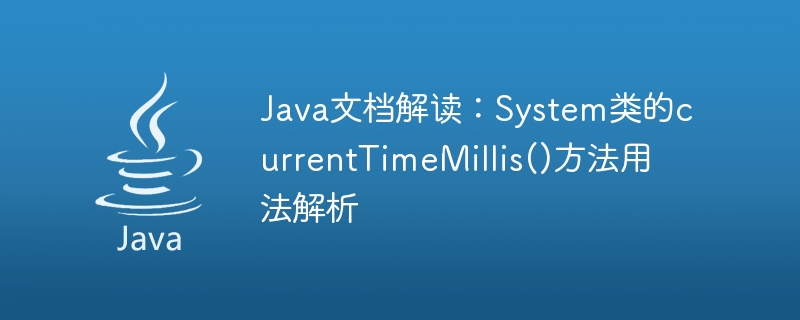 Java
Java
 javaTutorial
javaTutorial
 Java documentation interpretation: Usage analysis of the currentTimeMillis() method of the System class
Java documentation interpretation: Usage analysis of the currentTimeMillis() method of the System class
Java documentation interpretation: Usage analysis of the currentTimeMillis() method of the System class

Interpretation of Java documentation: Usage analysis of the currentTimeMillis() method of the System class, specific code examples are required
In Java programming, the System class is a very important class. It encapsulates some properties and operations related to the system. Among them, the currentTimeMillis method is a very commonly used method in the System class. This article will explain the method in detail and provide code examples.
1. Overview of currentTimeMillis method
First of all, let’s understand the basic information of this method:
Method name: currentTimeMillis
Method description: Return the current time (The unit is milliseconds), which is a long value.
Method syntax: public static long currentTimeMillis()
Return value: millisecond value of the current time, long type.
2. Detailed explanation of currentTimeMillis method
The currentTimeMillis method is a relatively simple method in the System class. Its only function is to obtain the milliseconds from the current time to 00:00:00 on January 1, 1970. number. Because the current time changes dynamically, the result returned is different every time this method is called.
Specific usage:
- Get the current timestamp
Use the currentTimeMillis method to get the current timestamp, which can easily determine the running time and processing time of the program. Wait for calculation.
Sample code:
long currentMillis = System.currentTimeMillis();
System.out.println("当前时间戳为:" + currentMillis);Output result:
当前时间戳为:1625940071601
- Calculate program running time
In Java programming, we sometimes need Calculate the running time of a certain piece of code to evaluate the performance of the code.
We can call currentTimeMillis once before executing the code, then call this method again after the code is executed, and then subtract the two results to get the code execution time.
Sample code:
long beginTime = System.currentTimeMillis();
// 程序执行代码
long endTime = System.currentTimeMillis();
long spendTime = endTime - beginTime;
System.out.println("程序执行时间为:" + spendTime + "毫秒");Output result:
程序执行时间为:45毫秒
3. Summary of currentTimeMillis method
The currentTimeMillis method is a very simple but very practical method that can Help us get the current time, calculate program running time, etc. This method can be used to easily calculate the program's running time, processing timeliness, etc., so as to better perform performance analysis and optimization.
The sample code provided in this article can help readers better understand and apply the currentTimeMillis method.
The above is the detailed content of Java documentation interpretation: Usage analysis of the currentTimeMillis() method of the System class. For more information, please follow other related articles on the PHP Chinese website!

Hot AI Tools

Undresser.AI Undress
AI-powered app for creating realistic nude photos

AI Clothes Remover
Online AI tool for removing clothes from photos.

Undress AI Tool
Undress images for free

Clothoff.io
AI clothes remover

AI Hentai Generator
Generate AI Hentai for free.

Hot Article

Hot Tools

Notepad++7.3.1
Easy-to-use and free code editor

SublimeText3 Chinese version
Chinese version, very easy to use

Zend Studio 13.0.1
Powerful PHP integrated development environment

Dreamweaver CS6
Visual web development tools

SublimeText3 Mac version
God-level code editing software (SublimeText3)

Hot Topics
 1376
1376
 52
52
 Square Root in Java
Aug 30, 2024 pm 04:26 PM
Square Root in Java
Aug 30, 2024 pm 04:26 PM
Guide to Square Root in Java. Here we discuss how Square Root works in Java with example and its code implementation respectively.
 Perfect Number in Java
Aug 30, 2024 pm 04:28 PM
Perfect Number in Java
Aug 30, 2024 pm 04:28 PM
Guide to Perfect Number in Java. Here we discuss the Definition, How to check Perfect number in Java?, examples with code implementation.
 Random Number Generator in Java
Aug 30, 2024 pm 04:27 PM
Random Number Generator in Java
Aug 30, 2024 pm 04:27 PM
Guide to Random Number Generator in Java. Here we discuss Functions in Java with examples and two different Generators with ther examples.
 Weka in Java
Aug 30, 2024 pm 04:28 PM
Weka in Java
Aug 30, 2024 pm 04:28 PM
Guide to Weka in Java. Here we discuss the Introduction, how to use weka java, the type of platform, and advantages with examples.
 Smith Number in Java
Aug 30, 2024 pm 04:28 PM
Smith Number in Java
Aug 30, 2024 pm 04:28 PM
Guide to Smith Number in Java. Here we discuss the Definition, How to check smith number in Java? example with code implementation.
 Java Spring Interview Questions
Aug 30, 2024 pm 04:29 PM
Java Spring Interview Questions
Aug 30, 2024 pm 04:29 PM
In this article, we have kept the most asked Java Spring Interview Questions with their detailed answers. So that you can crack the interview.
 Break or return from Java 8 stream forEach?
Feb 07, 2025 pm 12:09 PM
Break or return from Java 8 stream forEach?
Feb 07, 2025 pm 12:09 PM
Java 8 introduces the Stream API, providing a powerful and expressive way to process data collections. However, a common question when using Stream is: How to break or return from a forEach operation? Traditional loops allow for early interruption or return, but Stream's forEach method does not directly support this method. This article will explain the reasons and explore alternative methods for implementing premature termination in Stream processing systems. Further reading: Java Stream API improvements Understand Stream forEach The forEach method is a terminal operation that performs one operation on each element in the Stream. Its design intention is
 TimeStamp to Date in Java
Aug 30, 2024 pm 04:28 PM
TimeStamp to Date in Java
Aug 30, 2024 pm 04:28 PM
Guide to TimeStamp to Date in Java. Here we also discuss the introduction and how to convert timestamp to date in java along with examples.



